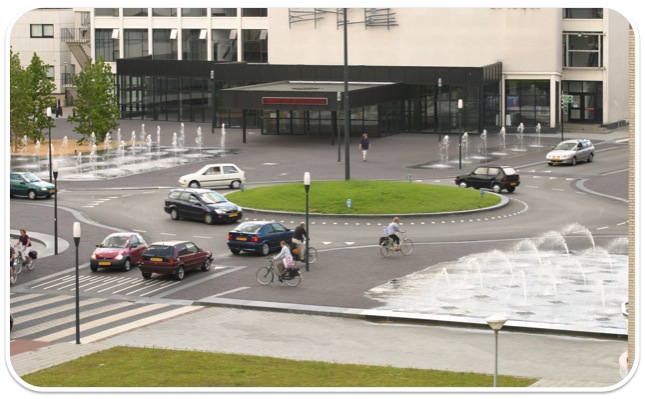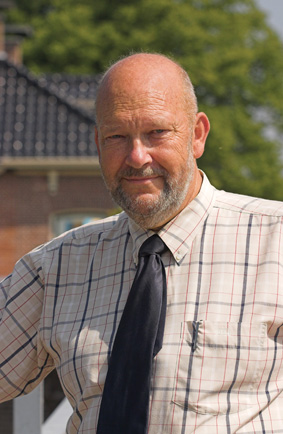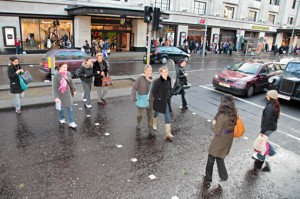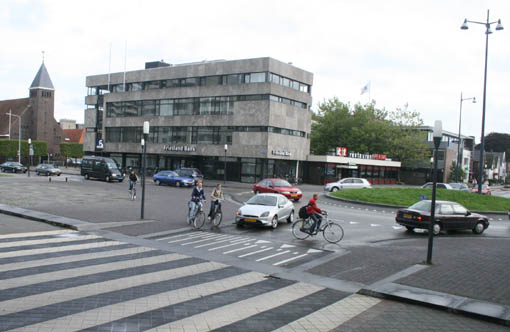Law and Order: Is It Time to Rethink the Rules of the Road?
- Written by
- Published in News
- font size decrease font size increase font size
- Be the first to comment!
 For most conscientious drivers, the rules of the road are like divine commandments: to be followed unquestioningly, as if passed down for all time from Mount Sinai on a graven tablet. Because they’re meant to preserve our safety, most of us willingly submit to them, giving up the freedom to drive however we please in the interest of the common good. This is the social contract all drivers enter into freely when they get behind the wheel. But the authority of the rules of the road is also reinforced in all sorts of ways, from stern warnings, speeding tickets, aggrieved honks, and demerit points to an elaborate infrastructure of traffic lights, street signs, road markings, speed bumps, and other mechanisms of control that are essential to rationalizing the flow of traffic and preventing a descent into a chaotic state of nature. Or so the argument usually goes.
For most conscientious drivers, the rules of the road are like divine commandments: to be followed unquestioningly, as if passed down for all time from Mount Sinai on a graven tablet. Because they’re meant to preserve our safety, most of us willingly submit to them, giving up the freedom to drive however we please in the interest of the common good. This is the social contract all drivers enter into freely when they get behind the wheel. But the authority of the rules of the road is also reinforced in all sorts of ways, from stern warnings, speeding tickets, aggrieved honks, and demerit points to an elaborate infrastructure of traffic lights, street signs, road markings, speed bumps, and other mechanisms of control that are essential to rationalizing the flow of traffic and preventing a descent into a chaotic state of nature. Or so the argument usually goes. But for Hans Monderman, the late Dutch traffic engineer who pioneered the urban-planning concept known as “shared space,” the notion of the right of way as a categorical true-or-false proposition was about as rational as the divine right of kings. Monderman’s shared-space design philosophy is based on the principle that people who use the roads should rely on their own judgment to determine amongst themselves who has the right of way under the particular traffic conditions at any given moment. In this system, the regulatory powers to govern traffic are transferred from the state to the individual and the community at large. The people have to take responsibility for their decisions without simply trusting in traditional control mechanisms like lane markings and yield signs to do the work for them.
But for Hans Monderman, the late Dutch traffic engineer who pioneered the urban-planning concept known as “shared space,” the notion of the right of way as a categorical true-or-false proposition was about as rational as the divine right of kings. Monderman’s shared-space design philosophy is based on the principle that people who use the roads should rely on their own judgment to determine amongst themselves who has the right of way under the particular traffic conditions at any given moment. In this system, the regulatory powers to govern traffic are transferred from the state to the individual and the community at large. The people have to take responsibility for their decisions without simply trusting in traditional control mechanisms like lane markings and yield signs to do the work for them.
To the conventional, rule-bound way of thinking, this scenario might sound like a catastrophe in the making. But Monderman was no crypto-anarchist. He believed that the main problem with the prescribed rules of the road is that they prevent drivers from exercising their own discretion. By regulating what we can and cannot do, street signs, traffic lights, and road markings relieve us somewhat of the need to think and act independently, undermining our autonomy and so diminishing our sense of personal accountability. A driver who sees a red light when approaching an intersection slows down to stop not because he’s scanned his surroundings and determined that stopping is the safest, sanest, most socially responsible course of action; he stops primarily because the law requires him to, regardless of what’s happening around him. Yet drivers shouldn’t be taking their cues from traffic lights, Monderman argued; they should be watching and communicating with the other human beings they share the streets with.
According to Monderman, in a strict rules-of-the-road-based traffic regime, drivers behave more like Pavlovian dogs than independent critical thinkers who are engaged with their surroundings. “Who has the right of way?” he once challenged in an interview with the New York Times. “I don’t care. People here have to find their own way, negotiate for themselves, use their own brains.” He was referring to the Dutch town of Drachten, where virtually all traffic lights, street signs, and road markings have been abolished since 2003 in a shared-space design initiative that he spearheaded. The town previously had reported an average of eight traffic fatalities per year. Today, the average is: zero. Paradoxically, the more “dangerous” the roads seem to become, the more safely people tend to drive, which ultimately makes the roads a safer place for everyone.

This counterintuitive logic is actually in line with a well-documented psychological phenomenon. Just as people behave more cautiously in the face of perceived danger, so they also behave less cautiously when they feel safe. It’s called risk compensation, and it helps explain why, for instance, owners of vehicles with antilock brakes tend to drive faster, follow closer, and brake later than owners of vehicles without them, or why people drive closer when passing cyclists who are wearing helmets than when passing cyclists who are helmetless. If the perceived risk is lower, it turns out that it’s only human to behave more recklessly.
On this basis, Monderman argued that, by creating an impression of relative safety and structure, traffic lights and signs cause people to become complacent, less alert, and so more prone to the sort of lapses that cause accidents in the first place. As soon as their light turns green, many drivers roll into the intersection as if nothing in the world could touch them. But even when you’ve got the right of way on your side, it doesn’t mean other drivers are going to do right by you. Danger is virtually a constant when you’re in a moving vehicle, and the greatest danger of all is in complacency. Surprisingly, the very measures and mechanisms designed to ensure our safety, the stop signs, the school crossings, the antilock brakes, and all the expensive gadgetry hardwired into our dashboards and hailed by manufacturers as state of the art – all of it may actually be diluting our impression of the reality of the danger around us, numbing us to it by transforming it into something remote, abstract, improbable.
In the shared-space school of urban design, it’s not lights, signs, and markings that regulate traffic but the configuration of the streets and intersections themselves. The width of the roads, the grade of inclines, the sharpness of turns, the placement of sidewalks, curbs, and medians, even the use of fountains, trees, and other environmental features to create a psychological calming effect on drivers – in each case, the goal is not to establish an infrastructure of enforcement and control but rather to bend driver behaviour to road design. A good example is the roundabout. Not only do these largely self-regulated circular junctions reduce bottlenecks and ease congestion, studies have also shown them to be far safer than traditional four-way intersections, where tense, hesitant drivers often face off like gunslingers in a Mexican standoff.
Drachten is not the only town to experiment successfully with Monderman’s shared-space concept. Towns and cities in Australia, New Zealand, Germany (home of the speed-limitless Autobahn), the Netherlands, Denmark, Sweden, the UK, and even the good old US of A have put the philosophy into practice to good effect, stripping city streets of traffic lights and removing lane divisions and curbs in order to create more communal, hospitable roads and cities. Of course, Monderman didn’t call for the complete elimination of control mechanisms. He acknowledged that such devices are necessary in areas with higher traffic density. But the core principle of shared-space design still holds: road architecture shapes not only the movement of traffic but also driver behaviour. Ultimately, if traffic rules are enforced like categorical imperatives, those who use the roads are apt to think less about whether their actions are safe, reasonable, or just than about whether their actions are merely legal.

